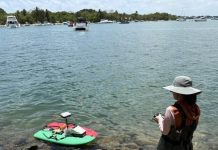People are willing to pay up to $18 annually for the next 10 years to avoid restrictions on how and when they can use water, according to a new FIU study. They are willing to part with even more cash — up to $22 annually — to protect and conserve the nearly 70 threatened and endangered plants and animals that call the Everglades home.
People, it turns out, connect better with Everglades restoration when it’s framed in the context of how they benefit and what they care about.
“Benefits resonate more with the public because they can be linked to their well-being,” said Nadia Seeteram, environmental studies alumna and lead author of the paper. “The findings present a unique opportunity for decision-makers to educate the public on where the resources they use come from and to garner support for restoration.”
For people to avoid water restrictions, there needs to be enough freshwater flowing through the Florida Everglades. That’s because the Everglades feeds into the water supplies of 16 counties in the state. This includes the Biscayne Aquifer, the primary source of drinking water for Broward, Miami-Dade, Monroe and Palm Beach counties.
The study builds upon a 1999 study examining public preferences for Everglades restoration. Since restoration is expected to take decades to complete, tracking changes in preferences over time provides valuable information to researchers and decision-makers. Long-term social, behavioral and economic data coupled with long-term ecological data will inform better natural resources policy, management and restoration, said Seeteram said.
Seeteram, who will join the New York City Department of Environment Protection as a climate and sustainability analyst, conducted the research as part of her master’s thesis alongside FIU environmental economist Pallab Mozumder.
“As we assess the economic values associated with Everglades restoration, we have an obligation to inform the public on the functioning of the ecosystem,” said Mozumder, a professor in the Department of Earth and Environment and the Department of Economics. “We need to be more innovative in communicating the benefits we receive from the ecosystem. We often say, value lies in the eye of beholder.”
The Florida Everglades is the largest subtropical wetland in North America. It has been degraded as a result of large-scale water management efforts to control flooding and promote agriculture and urban development. In 2000, U.S. Congress passed the Comprehensive Everglades Restoration Plan to increase freshwater flow throughout it, ultimately improving ecosystem health and the amount of freshwater available for people to consume.
Funded by the National Science Foundation, the study was a collaboration with the U.S. Geological Survey. It was published in Science of the Total Environment.






